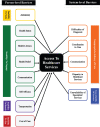Barriers to Accessing Healthcare Services for People with Parkinson's Disease: A Scoping Review
- PMID: 34308913
- PMCID: PMC8609702
- DOI: 10.3233/JPD-212735
Barriers to Accessing Healthcare Services for People with Parkinson's Disease: A Scoping Review
Abstract
Parkinson's disease is a complex condition that affects many different aspects of a person's health. Because of its complexity, people with Parkinson's disease require access to a variety of healthcare services. The aim of the present study was to identify the barriers to access healthcare services for people with Parkinson's disease. We conducted a scoping review according to guidelines posed by Arksey & O'Malley (2005). A search of MEDLINE, Embase, CINHAL, and PsycINFO databases was conducted, and 38 articles were selected based on the inclusion criteria. The review findings identified person-level and system-level barriers. The person-level barriers included skills required to seek healthcare services, ability to engage in healthcare and cost for services. The system-level barriers included the availability of appropriate healthcare resources. Based on the existing barriers elucidated in the scope review, we have discussed potential areas in healthcare that require improvement for people with Parkinson's disease to manage their healthcare needs more equitably.
Keywords: Parkinson’s disease; access barriers; healthcare services.
Conflict of interest statement
The authors have no conflict of interest to declare.
Figures
References
-
- Hirsch L, Jette N, Frolkis A, Steeves T, Pringsheim T (2016) The incidence of Parkinson’s disease: A systematic review and meta-analysis. Neuroepidemiology 46, 292–300. - PubMed
-
- Pringsheim T, Jette N, Frolkis A, Steeves TDL (2014) The prevalence of Parkinson’s disease: A systematic review and meta-analysis. Mov Disord 29, 1583–1590. - PubMed
-
- Grimes D, Firzpatrick M, Gordon J, Miyasaki J, Fon EA, Schlossmacher M, Suchowersky O, Rajput A, Lafontaine AL, Mestre T, Appel-Cresswell S, Kalia SK, Schoffer K, Zurowski M, Postuma RB, Udow S, Fox S, Barbeau P, Hutton B (2019) Canadian guideline for Parkinson disease. CMAJ 191, E989–1004. - PMC - PubMed
-
- Hobson DE, Lix LM, Azimaee M, Leslie WD, Burchill C, Hobson S (2012) Healthcare utilization in patients with Parkinson’s disease: A population-based analysis. Parkinsonism Relat Disord 18, 930–935. - PubMed
-
- Wolfson C, Fereshtehnejad SM, Pasquet R, Postuma R, Keezer MR (2019) High burden of neurological disease in the older general population: Results from the Canadian Longitudinal Study on Aging. Eur J Neurol 26, 356–362. - PubMed
Publication types
MeSH terms
LinkOut - more resources
Full Text Sources
Medical



